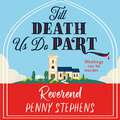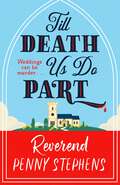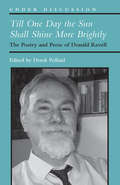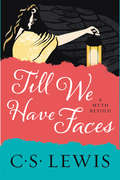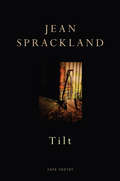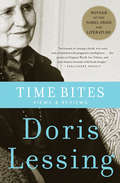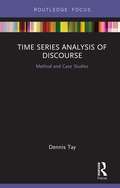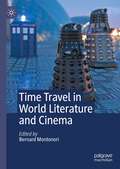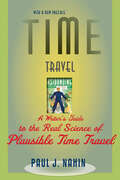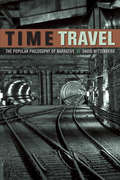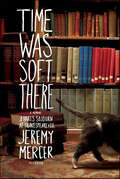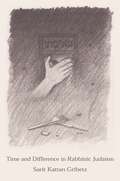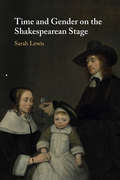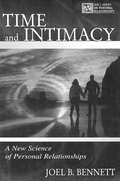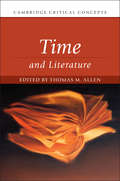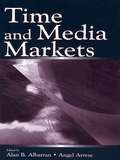- Table View
- List View
Till Death Us Do Part
by Penny Stephens'A new star in the crime-writing firmament' Elly GriffthsThe charming and delightfully cosy debut crime novel from Reverend Penny Stephens.Weddings can be murder . . .Reverend Clare Brakespear is used to a challenge. With a young family to wrangle, a parish to manage and a particularly excitable Golden Retriever by her side, life is never dull. But when she attends a wedding where one of the guests is fatally stabbed with a cake knife, even Clare admits that she might have been given too much to handle this time.As the police investigate the murder, they zero-in on one woman as their prime suspect, who they believe had the motive, means and opportunity to commit the crime. The trouble is, Clare is convinced that they have the wrong person. She might not understand forensic testing and finger-tip searches, but if there's one thing Clare does know, it's people and the complexities of their emotional lives. So she decides to take matters into her own hands. However, investigating a murder is no mean feat and Clare soon finds herself embroiled in a complex web of family secrets and deceptions. Is she in way over her head or can she find the real killer before an innocent woman is sent down?
Till Death Us Do Part: a charming and delightfully cosy mystery that will keep you hooked!
by Penny Stephens'A new star in the crime-writing firmament' Elly GriffthsThe charming and delightfully cosy debut crime novel from Reverend Penny Stephens.Weddings can be murder . . .Reverend Clare Brakespear is used to a challenge. With a young family to wrangle, a parish to manage and a particularly excitable Golden Retriever by her side, life is never dull. But when she attends a wedding where one of the guests is fatally stabbed with a cake knife, even Clare admits that she might have been given too much to handle this time.As the police investigate the murder, they zero-in on one woman as their prime suspect, who they believe had the motive, means and opportunity to commit the crime. The trouble is, Clare is convinced that they have the wrong person. She might not understand forensic testing and finger-tip searches, but if there's one thing Clare does know, it's people and the complexities of their emotional lives. So she decides to take matters into her own hands. However, investigating a murder is no mean feat and Clare soon finds herself embroiled in a complex web of family secrets and deceptions. Is she in way over her head or can she find the real killer before an innocent woman is sent down?
Till Death Us Do Part: a charming and delightfully cosy mystery that will keep you hooked!
by Penny Stephens'A new star in the crime-writing firmament' Elly GriffthsThe charming and delightfully cosy debut crime novel from Reverend Penny Stephens.Weddings can be murder . . .Reverend Clare Brakespear is used to a challenge. With a young family to wrangle, a parish to manage and a particularly excitable Golden Retriever by her side, life is never dull. But when she attends a wedding where one of the guests is fatally stabbed with a cake knife, even Clare admits that she might have been given too much to handle this time.As the police investigate the murder, they zero-in on one woman as their prime suspect, who they believe had the motive, means and opportunity to commit the crime. The trouble is, Clare is convinced that they have the wrong person. She might not understand forensic testing and finger-tip searches, but if there's one thing Clare does know, it's people and the complexities of their emotional lives. So she decides to take matters into her own hands. However, investigating a murder is no mean feat and Clare soon finds herself embroiled in a complex web of family secrets and deceptions. Is she in way over her head or can she find the real killer before an innocent woman is sent down?
Till One Day the Sun Shall Shine More Brightly: The Poetry and Prose of Donald Revell (Under Discussion)
by Derek PollardSince the publication of From the Abandoned Cities in 1983, Donald Revell has been among the more consistent influencers in American poetry and poetics. Yet, his work has achieved the status it has—his honors include fellowships from the National Endowment for the Arts and the Guggenheim Foundation and awards from the PEN Center USA and American Poetry Review—in a manner that has often tended to belie its abiding significance. This collection of essays, reviews, and interviews is designed to ignite a more wide-ranging critical appraisal of Revell’s writing, from his fourteen collections of poems to his acclaimed translations of French symbolist and modernist poets to his artfully constructed literary criticism. Contributors such as Marjorie Perloff, Stephanie Burt, Dan Beachy-Quick, and Bruce Bond examine key elements in and across Revell’s work, from his visionary postmodernism (“Our words can never say the mystery of our meanings, but there they are: spoken and meaning worlds to us”) to his poetics of radical attention (“And so a poem has nothing to do with picking and choosing, with the mot juste and reflection in tranquility. It is a plain record of one’s entire presence”), in order to enlarge our understanding of how and why that work has come to occupy the place that it has in contemporary American letters.
Till We Have Faces: A Myth Retold (G. K. Hall Perennial Bestsellers Ser.)
by C. S. LewisA repackaged edition of the revered author’s retelling of the myth of Cupid and Psyche—what he and many others regard as his best novel.C. S. Lewis—the great British writer, scholar, lay theologian, broadcaster, Christian apologist, and bestselling author of Mere Christianity, The Screwtape Letters, The Great Divorce, The Chronicles of Narnia, and many other beloved classics—brilliantly reimagines the story of Cupid and Psyche. Told from the viewpoint of Psyche’s sister, Orual, Till We Have Faces is a brilliant examination of envy, betrayal, loss, blame, grief, guilt, and conversion. In this, his final—and most mature and masterful—novel, Lewis reminds us of our own fallibility and the role of a higher power in our lives.
Tilt
by Jean SpracklandJean Sprackland's third collection describes a world in free-fall. Chaos and calamity are at our shoulder, in the shape of fire and flood, ice-storm and hurricane; trains stand still, zoos are abandoned, migrating birds lose their way - all surfaces are unreliable, all territories unmapped. These are poems that explore the ambivalence and dark unease of slippage and collapse, but they also carry a powerful sense of the miraculous made manifest amongst the ordinary: the mating of natterjack toads, ice on the beach ('dream stuff, with its own internal acoustic') or 'the fund of life' in a used contraceptive. Bracken may run wild across the planet 'waiting for the moment/to pounce on the accident/of the discarded match' but there are also the significant wonders of children and the natural beauty of the world they've inherited. Tilt is a collection of raw, distressed and beautiful poems, a hymn to the remarkable survival of things in the face of threat - for every degradation an epiphany, for every drowning a birth.
Tim (Primary Phonics Storybook #Set 1 Book 4)
by Barbara MakarA systematic, phonics-based early reading program that includes: the most practice for every skill, decodable readers for every skill, and reinforcement materials--help struggling students succeed in the regular classroom
Tim O'Brien: The Things He Carries and the Stories He Tells (Routledge Studies In Contemporary Literature Ser.)
by Tobey C HerzogThis collection of seven essays, like the carefully linked collection of vignettes within Tim O’Brien’s most popular book The Things They Carried, contains multiple critical and biographical angles with recurring threads of life events, themes, characters, creative techniques, and references to all of O’Brien’s books. Grounded in through research, Herzog’s work illustrates how O’Brien merges his life experiences with his creative production; he rarely misses an opportunity to introduce these critical life events into his writing.
Timaeus of Tauromenium and Hellenistic Historiography
by Christopher A. BaronTimaeus of Tauromenium (350-260 BC) wrote the authoritative account of the Greeks in the Western Mediterranean. Like almost all the Hellenistic historians, his work survives only in fragments. Beyond an up-to-date treatment of this important author, this book shows that both the nature of the evidence and modern assumptions about historical writing in the Hellenistic period have skewed our treatment and judgement of lost historians. For Timaeus, much of our evidence is preserved in the polemical context of Polybius' Book 12. When we move outside that framework and examine the fragments of Timaeus in their proper context, we gain a greater appreciation for his method and his achievement, including his use of polemical invective and his composition of speeches. This examination of Timaeus also conveys a broader impression of the major lines of Hellenistic historiography.
Time Bites
by Doris LessingIn this collection of the very best of Doris Lessing's essays, we are treated to the wisdom and keen insight of a writer who has learned, over the course of a brilliant career spanning more than half a century, to read the world differently. From imagining the secret sex life of Tolstoy to the secrets of Sufism, from reviews of classic books to commentaries on world politics, these essays cover an impressive range of subjects, cultures, periods, and themes, yet they are remarkably consistent in one key regard: Lessing's clear-eyed vision and clearly expressed prose.
Time Series Analysis of Discourse: Method and Case Studies (Routledge Studies in Linguistics)
by Dennis TayThis volume serves as a comprehensive introduction to Time Series Analysis (TSA), used commonly in financial and engineering sciences, to demonstrate its potential to complement qualitative approaches in discourse analysis research. The book begins by discussing how time has previously been conceptualized in the literature, drawing on studies from variationist sociolinguistics, corpus linguistics, and Critical Discourse Analysis. The volume then segues into a discussion of how TSA is applied in other contexts in which observed values are expected to be dependent on earlier values, such as stock markets and sales figures, and introduces a range of discourse-specific contexts to show how the technique might be extended to analyze trends or shed further light on relevant themes in discourse over time. Each successive chapter features a different discourse context as a case study, from psychotherapy sessions, university lectures, and news articles, and looks at how studying different variables over time in each context – metaphors, involvement markers, and keywords, respectively – can contribute to a greater understanding of both present and future discourse activity in these settings. Taken together, this book highlights the value of TSA as a complementary approach to meaning-based analysis in discourse, making this ideal reading for graduate students and scholars in discourse analysis looking to employ quantitative methods in their research practice.
Time Slips: Queer Temporalities, Contemporary Performance, and the Hole of History
by Jaclyn I. PryorPryor illuminates how each artist deploys performance as a tool to render history visible, trauma recognizable, and transformation possible by laying bare the histories and ongoing systems of violence woven deep into our society.
Time To Know Them: A Longitudinal Study of Writing and Learning at the College Level
by Marilyn S. SternglassIn a time of declining resources in institutions of higher education, we grapple with how priorities are to be set for the limited resources available. Most vulnerable are those students labeled underprepared by colleges and universities. Should we argue that the limited resources available ought to be used to support these students through their undergraduate years? And, if we decide that we want to do that, what evidence of their potential for success can we provide that will justify the use of these resources? Through longitudinal research that follows students who have been so labeled over all their college years, we can begin to find answers to these questions. Time to Know Them is the first book that follows the experiences of a group of students over their entire academic experience. No previous studies have brought together the factors incorporated in this study: *examining writing and learning on a true longitudinal basis; *studying a multicultural urban population; *investigating the relationship between writing and learning by examining papers written over time for regularly assigned academic courses across a range of disciplines; and *taking into consideration non-academic factors that influence academic performance such as race, gender, socio-economic status, and ideological orientation. Through interviews twice a semester over six years, the collection of papers written for all courses, observations of instructional settings, and analysis of required institutional tests of writing, the author has been able to pull together a more complete picture of writing and intellectual development over the college years than has previously been available in any study. Students are seen to acquire the ability to handle more complex reasoning tasks as they find themselves in more challenging intellectual settings and where risk-taking and exploration of new ideas are valued. The integration of students' previous life experiences into their academic studies allows them to analyze, critique, modify, and apply their previously held world views to their new learning. These changes are seen to occur over time with instructional settings and support providing key roles in writing development. Personal factors in students' lives present difficulties that require persistence and dedication to overcome. Never before have the complexities of real individual lives as they affect academic performance been so clearly presented.
Time Travel in World Literature and Cinema
by Bernard MontoneriTime Travel in World Literature and Cinema discusses various literary works, movies, and TV series with a special focus on time travel. Each chapter is written by professors and scholars from various countries, including the US, Japan, Germany, France, Spain, Taiwan, South Africa, Qatar, Russia, Ukraine and Australia. The book addresses themes of racism, sexism, feminism, and social injustice as well as dystopian futures. This will appeal to students and scholars studying science fiction, dystopian literature, world literature, and world cinema.
Time Travel in the Latin American and Caribbean Imagination
by Rudyard J. AlcocerCombining in innovative ways the tools and approaches of postcolonial and popular culture studies as well as comparative literary analysis, this is an ambitious, interdisciplinary study that develops - across several related discursive sites - an argument about the centrality of time travel in the Latin American and Caribbean imagination.
Time Travel: A Writer's Guide to the Real Science of Plausible Time Travel
by Paul J. NahinFrom H.G. Wells to Isaac Asimov to Ursula K. Le Guin, time travel has long been a favorite topic and plot device in tales of science fiction and fantasy. But as any true SF fan knows, astounding stories about traversing alternate universes and swimming the tides of time demand plausible science. That’s just what Paul J. Nahin’s guide provides.An engineer, physicist, and published science fiction writer, Nahin is uniquely qualified to explain the ins and outs of how to spin such complex theories as worm holes, singularity, and relativity into scientifically sound fiction. First published in 1997, this fast-paced book discusses the common and not-so-common time-travel devices science fiction writers have used over the years, assesses which would theoretically work and which would not, and provides scientific insight inventive authors can use to find their own way forward or backward in time. From hyperspace and faster-than-light travel to causal loops and the uncertainty principle and beyond, Nahin’s equation-free romp across time will help writers send their characters to the past or future in an entertaining, logical, and scientific way.If you ever wanted to set up the latest and greatest grandfather paradox—or just wanted to know if the time-bending events in the latest pulp you read could ever happen—then this book is for you.
Time Travel: The Popular Philosophy of Narrative (Gothic Fantasy Ser.)
by David WittenbergThis book argues that time travel fiction is a narrative “laboratory,” a setting for thought experiments in which essential theoretical questions about storytelling—and, by extension, about the philosophy of temporality, history, and subjectivity—are represented in the form of literal devices and plots.Drawing on physics, philosophy, narrative theory, psychoanalysis, and film theory, the book links innovations in time travel fiction to specific shifts in the popularization of science, from evolutionary biology in the late 1800s, through relativity and quantum physics in the mid–20th century, to more recent “multiverse” cosmologies. Wittenberg shows how increasing awareness of new scientific models leads to surprising innovations in the literary “time machine,” which evolves from a “vehicle” used chiefly for sociopolitical commentary into a psychological and narratological device capable of exploring with great sophistication the temporal structure and significance of subjects, viewpoints, and historical events.The book covers work by well-known time travel writers such as H. G. Wells, Edward Bellamy, Robert Heinlein, Samuel Delany, and Harlan Ellison, as well as pulp fiction writers of the 1920s through the 1940s, popular and avant-garde postwar science fiction, television shows such as “The Twilight Zone” and “Star Trek,” andcurrent cinema. Literature, film, and TV are read alongside theoretical work ranging from Einstein, Schrödinger, and Stephen Hawking to Gérard Genette, David Lewis, and Gilles Deleuze. Wittenberg argues that even the most mainstream audiences of popular time travel fiction and cinema are vigorously engaged with many of the same questions about temporality, identity, and history that concern literary theorists, media and film scholars, and philosophers.
Time Was Soft There: A Memoir: A Paris Sojourn at Shakespeare & Co.
by Jeremy Mercer"Some bookstores are filled with stories both inside and outside the bindings. These are places of sanctuary, even redemption---and Jeremy Mercer has found both amid the stacks of Shakespeare & Co."---Paul Collins, author of Sixpence House: Lost in a Town of BooksIn a small square on the left bank of the Seine, the door to a green-fronted bookshop beckoned. . . .With gangsters on his tail and his meager savings in hand, crime reporter Jeremy Mercer fled Canada in 1999 and ended up in Paris. Broke and almost homeless, he found himself invited to a tea party amongst the riffraff of the timeless Left Bank fantasy known as Shakespeare & Co. In its present incarnation, Shakespeare & Co. has become a destination for writers and readers the world over, trying to reclaim the lost world of literary Paris in the 1920s. Having been inspired by Sylvia Beach's original store, the present owner, George Whitman, invites writers who are down and out in Paris to live and dream amid the bookshelves in return for work. Jeremy Mercer tumbled into this literary rabbit hole and found a life of camaraderie with the other eccentric residents, and became, for a time, George Whitman's confidante and right-hand man. Time Was Soft There is one of the great stories of bohemian Paris and recalls the work of many writers who were bewitched by the City of Light in their youth. Jeremy's comrades include Simon, the eccentric British poet who refuses to give up his bed in the antiquarian book room, beautiful blonde Pia, who contributes the elegant spirit of Parisian couture to the store, the handsome American Kurt, who flirts with beautiful women looking for copies of Tropic of Cancer, and George himself, the man who holds the key to it all. As Time Was Soft There winds in and around the streets of Paris, the staff fall in and out of love, straighten bookshelves, host tea parties, drink in the more down-at-the-heels cafés, sell a few books, and help George find a way to keep his endangered bookstore open. Spend a few days with Jeremy Mercer at 37 Rue de la Bucherie, and discover the bohemian world of Paris that still bustles in the shadow of Notre Dame."Jeremy Mercer has captured Shakespeare & Co. and its complicated owner, George Whitman, with remarkable insight. Time Was Soft There is a charming memoir about living in Whitman's Shakespeare & Co. and the strange, broken, lost, and occasionally talented, eccentrics and residents of this Tumblewood Hotel."---Noel Riley Fitch, author of Sylvia Beach and the Lost Generation: A History of Literary Paris in the Twenties & Thirties"There does seem to be something about the odd ducks that work at bookstores. Jeremy Mercer has captured the story of a wonderful, unique store that could only be born out of a love for books and the written word."--- Liz Schlegel, the Book Revue bookshop, Huntington, New York
Time and Causality in Early Modern Drama: Plotting Revenge (Routledge Studies in Renaissance Literature and Culture)
by Linc KeslerThe opening of the first commercial theatre in London in 1579 initiated a pattern of development that radically reshaped representation. The competition among theatres required the constant production of new works, creating an interplay between the innovations of producers and the rapidly changing perceptions of audiences. The result was a process of incremental change that redefined perceptions of time, action, and identity. Aristotle in the Poetics contrasted a similar set of formal developments to the earlier system of the epics, which, like many predecessors of early modern drama, had emerged from largely oral traditions. Located in the context of contemporary relations between the academy and Indigenous communities, Time and Causality in Early Modern Drama: Plotting Revenge traces these developments through changes in the revenge tragedy form and questions our abilities, habituated to literacy, to fully understand or appreciate the complexity and operations of oral systems.The Open Access version of this book, available at http://www.taylorfrancis.com, has been made available under a Creative Commons [Attribution-Non Commercial-No Derivatives (CC-BY-NC-ND)] 4.0 license.
Time and Concept in Tamil Literature: தமிழ் இலக்கியத்தில் காலமும் கருத்தும்
by Prof. A. Veluppillaiதமிழ்ச் சிந்தனையின். வரலாற்றை உணர்ந்து கொள்வதற்குத் ‘தமிழிலக்கியத்தில் காலமும் கருத்தும்’ என்ற இந்நூல் ஓரளவு துணைபுரியும்.. தமிழ்நாட்டார் சங்கதம் முதலிய மொழிகளில் எழுதிய நூல்களும் பிற நாட்டார் தமிழரைப் பற்றி வெவ்வேறு காலத்தில் வெளியிட்ட கருத்துக்களும் புதை பொருளாராய்ச்சி, மொழியியல் ஆராய்ச்சி முதலியவைகளால் புலப்படும் தமிழர் வாழ்க்கை பற்றிய செய்திகளும் இங்கு உதவக் கூடியன. ஆனால் இந்நூல் இலக்கியங்களிலிருந்து மட்டும் கருத்துக்களை எடுத்து ஆராய்கிறது. இலக்கியம் என்ற சொல் பரந்த பொருளில் இந்நூல் கையாளப்படுகிறது
Time and Difference in Rabbinic Judaism
by Professor Sarit Kattan GribetzHow the rabbis of late antiquity used time to define the boundaries of Jewish identityThe rabbinic corpus begins with a question–“when?”—and is brimming with discussions about time and the relationship between people, God, and the hour. Time and Difference in Rabbinic Judaism explores the rhythms of time that animated the rabbinic world of late antiquity, revealing how rabbis conceptualized time as a way of constructing difference between themselves and imperial Rome, Jews and Christians, men and women, and human and divine.In each chapter, Sarit Kattan Gribetz explores a unique aspect of rabbinic discourse on time. She shows how the ancient rabbinic texts artfully subvert Roman imperialism by offering "rabbinic time" as an alternative to "Roman time." She examines rabbinic discourse about the Sabbath, demonstrating how the weekly day of rest marked "Jewish time" from "Christian time." Gribetz looks at gendered daily rituals, showing how rabbis created "men's time" and "women's time" by mandating certain rituals for men and others for women. She delves into rabbinic writings that reflect on how God spends time and how God's use of time relates to human beings, merging "divine time" with "human time." Finally, she traces the legacies of rabbinic constructions of time in the medieval and modern periods.Time and Difference in Rabbinic Judaism sheds new light on the central role that time played in the construction of Jewish identity, subjectivity, and theology during this transformative period in the history of Judaism.
Time and Gender on the Shakespearean Stage
by Sarah LewisThis book analyses the cultural and theatrical intersections of early modern temporal concepts and gendered identities. Through close readings of the works of Shakespeare, Middleton, Dekker, Heywood and others, across the genres of domestic comedy, city comedy and revenge tragedy, Sarah Lewis shows how temporal tropes are used to delineate masculinity and femininity on the early modern stage, and vice versa. She sets out the ways in which the temporal constructs of patience, prodigality and revenge, as well as the dramatic identities that are built from those constructs, and the experience of playgoing itself, negotiate a fraught opposition between action in the moment and delay in the duration. This book argues that looking at time through the lens of gender, and gender through the lens of time, is crucial if we are to develop our understanding of the early modern cultural construction of both.
Time and Intimacy: A New Science of Personal Relationships (LEA's Series on Personal Relationships)
by Joel B. BennettThere is a mysterious connection between our experiences of intimacy--of love, the longing to feel connected, and sexual embrace--and the human sense of time--eternity, impermanence, and rhythm. In this critical analysis of the time-intimacy equation, Bennett shows how the scientific study of personal relationships can address this mystery. As a study of transpersonal science, this book points to the possible evolution of intimacy and of our consciousness of time, and how the two evolutionary paths weave together. Dr. Bennett draws from a wide array of resources to advance and marry two compelling themes: first, the social and clinical science of personal relationships should integrate the spiritual or transpersonal dimension of intimacy, and second, science can contribute to lay understandings by describing the richly temporal aspects of relationships. In blending popular literature, transpersonal psychology, and scientific research and theory, this work also attempts to address the lack of dialogue between academics who study personal intimacy and those writers in the popular press who give advice and guidelines for building intimacy. Time and Intimacy is written for a broad audience, intended for those with a general interest in relationships, as well as for students, counselors, and psychologists. It can be used as a text in courses on personal relationships, as well as to supplement courses in humanistic psychology, transpersonal psychology, interpersonal communication, relationships, marital and family counseling, human relations, and related areas. Because it advances an interdisciplinary understanding of personal relationships, this book is certain to challenge prevailing views about the meaning of intimacy in both the academic and popular literatures.
Time and Literature (Cambridge Critical Concepts )
by Thomas M. AllenTime and Literature features twenty essays on topics from aesthetics and narratology to globalization and queer temporalities and showcases how time studies, often referred to as “the temporal turn,” cuts across and illuminates research in every field of literature, as well as interdisciplinary approaches drawing on history, philosophy, anthropology, and the natural sciences. Part I, “Origins,” addresses fundamental issues that can be traced back to the beginnings of literary criticism, while Part II, “Development,” shows how thinking about time has been crucial to various interpretive revolutions that have affected literary theory. Part III, “Application,” illustrates the centrality of temporal theorizing to literary criticism in a variety of contemporary approaches, from ecocriticism and new materialisms to media and archive studies. The first anthology to provide a synthesis of recent scholarship on the temporality of literary language from across different national and historical periods, Time and Literature will appeal to academic researchers and interested laypersons alike.
Time and Media Markets (Routledge Communication Series)
by Alan B. Albarran Angel Arrese RecaThis edited collection examines time and its relationship to and impact upon media industries, studying how the media industry views time and makes business and economic decisions based on considerations of time. Contributions from an international set of authors analyze time constraints and competition between different media; the quantity and quality of time spent in media consumption, audience and readership time valuation/costing/pricing; and the emergence of new media businesses around individual time management. Specific topics examined in the volume include: * a philosophical look at the concept of time and its application to media markets; * temporal aspects of media distribution for the media industries, and how time affects their activities; * the impact of increasing media industry consolidation and convergence on managerial effectiveness; * approaches to time by CNN and its various cache of news channels, in a managerial context; * the application of niche theory as a framework to examine competition between the Internet and television; * Internet access in the United Kingdom and Europe, examining the cost of time for online access; * the exchange of time and money in the television market for advertising; and * a summary of research and an agenda for future research on the topic of time's role in the media industry and markets. With its origins in the third World Media Economics conference, held in 2000, Time and Media Markets is a distinctive and important collection appropriate for scholars and advanced students in media management and economics.
